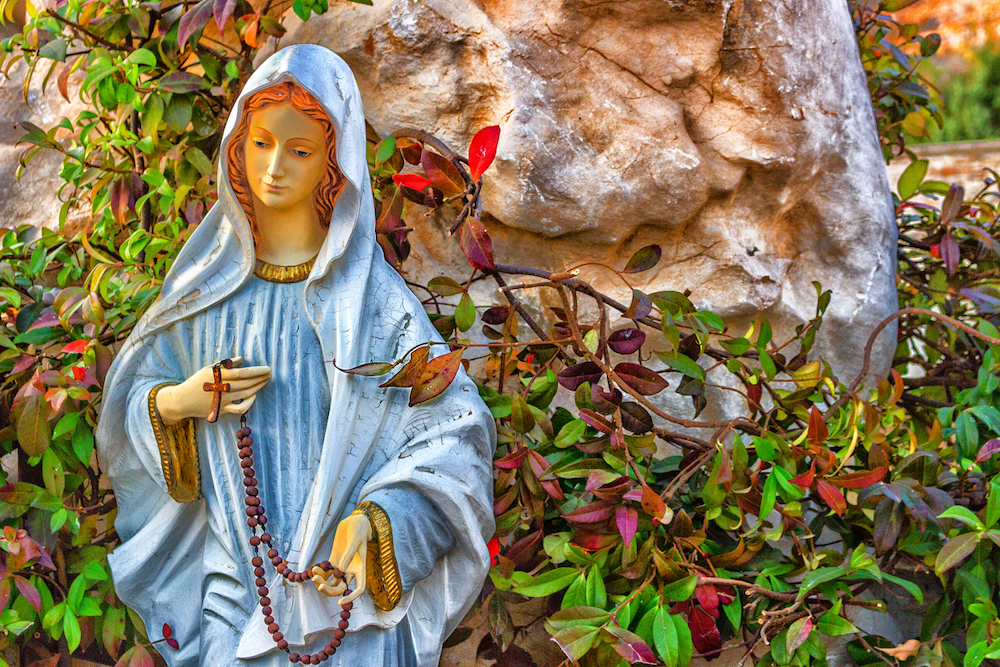No month of the year passes without the Church celebrating a solemnity, feast or memorial in honor of Mary. However, October has special significance in that it commemorates the importance of the rosary as a favorite prayer of Mary – and with good reason.
“To Jesus through Mary” was a favorite saying of St. Louis de Montford, reminding us that Mary was the chosen vehicle that brought Christ to the world. St. John Paul II called the rosary the “compendium of the Gospel,” and Pope Francis cited “Mary as the road to Jesus.”
Although Franciscans are not usually associated with Mary, St. Anthony of Padua compared Mary to a rainbow, which is a sign of peace and reconciliation. So highly did the saint esteem our heavenly mother that he claimed we have three advocates: the Holy Spirit, Christ and Mary. St. Dominic, long associated with the rosary, viewed the rosary as the perfect combination of vocal and mental prayer, giving credence to it being called “the school of prayer.”
Little effort is required in repeating the prayers that make up the rosary. They are as familiar to Catholics as our own names, which allows the words to flow fluently from our lips. In this way, the rosary facilitates our being present to Jesus just as he is present to us. When our minds wander, we gently return to the scene of the mystery so that the words rooted in Scripture fall from our lips in sweet praise of God.
St. Jerome considered the truths contained in the rosary so sublime and so wonderful that neither angels nor humans could fully understand them.
During these troubled times, as in times past, when war, dissension and famine abound, we do well to have recourse to Mary who is called “Queen of Peace.” St. John Paul II, who grew up in the shadow of communist suppression, wrote, “From my youthful years, the rosary has held an important place in my life.”
When the Soviet hammer and sickle flag was lowered for the last time over the Kremlin, and Mikhail Gorbachev resigned his post as president of the Soviet Union, those who are familiar with Fatima immediately drew a connection between the event and the pope’s proclamation in response to Our Lady’s request to consecrate Russia to her Immaculate Heart.
Many regarded the fall of communism in the Soviet Union and the collapse of the Berlin wall as a definitive response to Mary’s request. At the time, no one could have envisioned the invasion of Ukraine by Russia only decades later. Clearly, life is not static, so challenges continue, as must our prayers for divine intervention.
Perhaps part of the reason we have difficulty with the ongoing threat of evil is because of a lack of understanding about apparitions and their prophetic utterances. According to St. Thomas Aquinas, “Apparitions have more to do with hope than faith. They shape the future. They bring the Gospel to life in a prophetic manner in new historical and geographical situations.”
The function of apparitions is not to complete the Gospel, but to open our eyes and ears to actualize it. The power behind praying the rosary is because it changes the hearts of those who pray it as well as the hearts of those for whom the rosary is intended.
We know that throughout the history of the Church, Mary has appeared to her children, pleading for them to convert and turn their hearts to her son who loved them unto death. The fruits of her apparitions continue as people are converted, return to the sacraments, and experience physical and spiritual healing.
Although apparitions are not part of the deposit of faith, why would anyone – given Mary’s privileged position within the Church and salvation history – be dismissive of a message that ought to strengthen our faith since it comes from the Queen of Heaven and Earth?
Mary and Joseph enjoyed visions, as did Moses and Elijah, Peter and Paul, to name only a few. If these great saints needed help from on high, it seems presumptuous to assume that such help is no longer needed.
Knowing our weakness, Mary offers us the rosary as a way to enter more deeply into the mysteries of her son and to learn of his mercy. With so many saints attesting to the power of Mary’s intercession through the rosary, why would we not make use of the heavenly aid that has been dubbed “garden of roses”?
Much of the above has been excerpted from my book, “Mary the Perfect Contemplative: Carmelite Insights into the Interior Life of Our Lady.”

